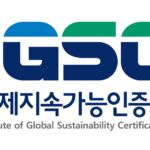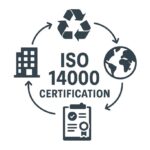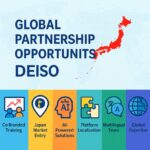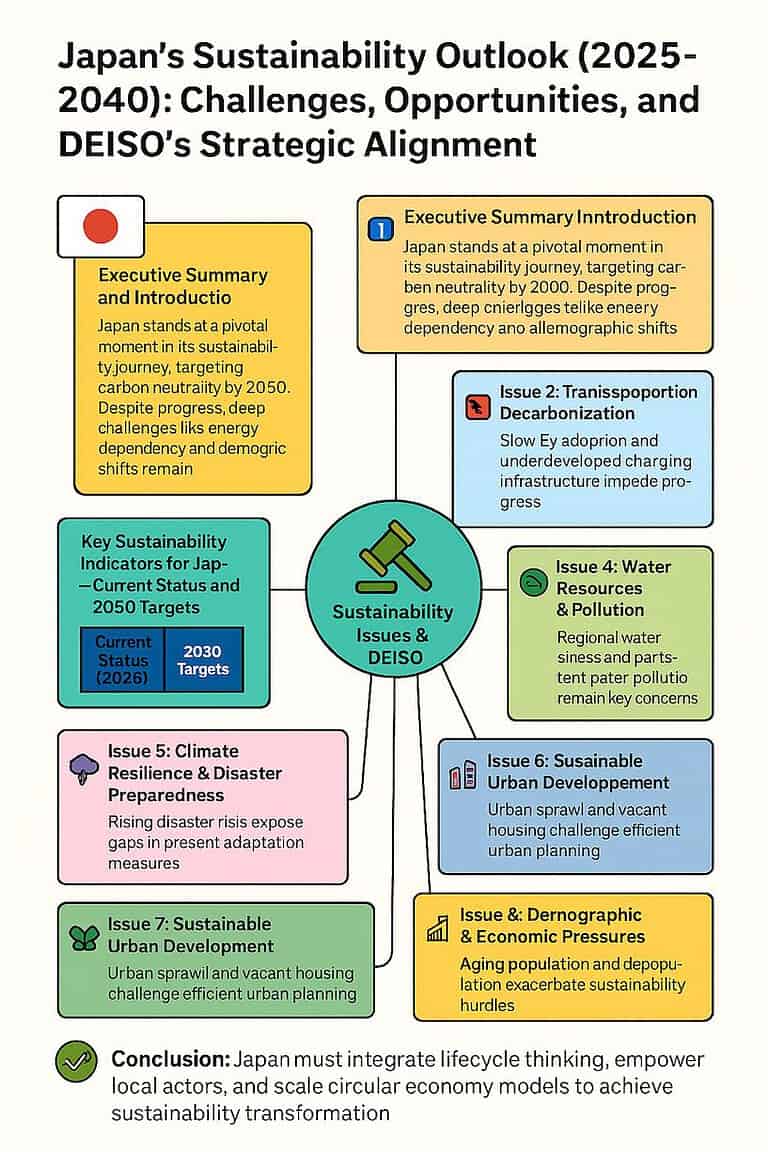
✍️ Executive Summary and Introduction
Japan stands at a defining moment in its environmental and sustainability journey. With its ambition to reach carbon neutrality by 2050 and achieve significant milestones by 2030, the country is undertaking one of the most complex sustainability transitions among industrialized nations. Progress has been made—GHG emissions have declined, waste-to-energy systems have become more efficient, and biodiversity protection is gaining policy support. Yet, the road ahead is steep. Japan’s energy dependence, demographic headwinds, fragmented data systems, and evolving international trade policies present intertwined obstacles.
This report presents a comprehensive outlook on Japan’s sustainability challenges through 2040. It outlines 19 key environmental and governance issues, each evaluated for national relevance and aligned with services from DEISO LLC, an environmental sustainability firm based in Japan. With a portfolio of premium training programs, AI-powered tools, and science-based consulting services, DEISO empowers organizations, municipalities, and professionals to meet policy targets and lead Japan’s green transformation
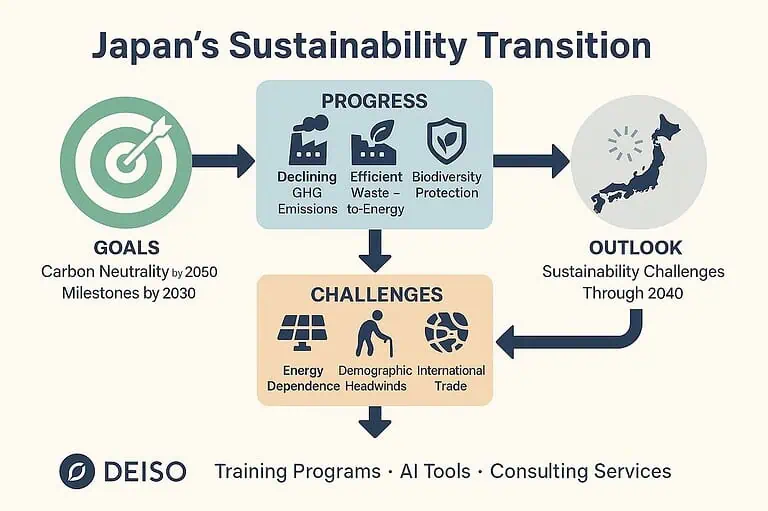
| Indicator | Current Status (2025) | 2030 Goal / Target |
|---|---|---|
| Population | ~123 million (declining ~0.5% annually) [1] | ~116 million projected, aging trend continues [2] |
| GHG Emissions | 1.15 billion tonnes CO₂e (2022/23) [3] | 0.76 billion tonnes (46% below 2013) [4] |
| Renewable Electricity Share | ~23% of electricity generation (2023) [5] | 36–38% [6] |
| Nuclear Electricity Share | ~5% of electricity generation (2022/23) [7] | 20–22% [8] |
| Fossil Electricity Share | ~73% of electricity mix (2022/23) | ~41% (based on combined nuclear + renewables targets) |
| New Car Sales – EVs | 3.6% fully electric vehicles (2023) [9] | ~20% fully electric; 100% \"electrified\" including hybrids by 2035 [10] |
| Municipal Waste Recycling Rate | ~20% recycling rate [11] | >20%, with increase targeted via Circular Economy Plan [12] |
| Waste Disposal – Landfill | <2% of municipal waste landfilled (most incinerated) [13] | Less incineration, more reuse/recycling per CE strategy |
| Protected Areas – Biodiversity | 20.6% land, 13.3% marine protected [14] | 30% land and sea protected by 2030 (30×30 goal) [15] |
| Verified EPD Coverage | Limited among Japanese manufacturers [16] | Expansion of ISO/EN-conformant EPDs in construction and electronics sectors [16] |
| Localized LCI Data Availability | Low; relies on foreign datasets [17] | National datasets aligned with Japan’s energy and industrial context [17] |
| SME ESG Reporting Adoption | Low in SMEs due to digital and capacity gaps [18] | Broad SME enablement through standardized ESG platforms [18] |
| Scope 3 Emissions Disclosure | Partial; rarely includes upstream/downstream [19] | Full integration of Scope 3 in national frameworks and corporate disclosures [19] |
| Scope 4 (Avoided Emissions) Adoption | Minimal use of Scope 4 metrics [20] | Increased adoption in clean tech sectors to demonstrate impact potential [20] |
| Public Sector Sustainability Training | Inconsistent across local governments [21] | Widespread rollout of GX- and ESG-aligned public training and capacity building [21] |
| Green Public Procurement Share | Underdeveloped implementation [22] | Strategic procurement tied to LCA, EPD, and carbon footprint metrics [22] |
| Carbon Border Adjustment Readiness | Early-stage awareness [23] | PCF-ready exporters aligned with CBAM and global climate trade frameworks [23] |
| Integrated Planning Adoption (ICEM) | Fragmented across ministries and sectors [24] | Multi-impact planning for energy, climate, and materials under unified national policy [24] |
📚 Sources
- en.wikipedia.org
- ipss.go.jp
- Reuters (2023)
- MOE Japan
- IEA, Climate Transparency (2023)
- METI Strategic Energy Plan
- World Nuclear Association
- MOE Japan Roadmap
- WEF (2023)
- METI Mobility Strategy
- MOE Waste Management Survey
- Plastic Resource Circulation Act
- MOE Circular Economy Report
- Biodiversity Strategy of Japan (2023–2030)
- CBD Japan
- Japan EPD Registry
- LCI Localization Study (JETRO)
- SME Sustainability Survey
- Climate Transparency Scope 3 Review
- WBCSD Avoided Emissions Guidance
- ESG Readiness for Local Governments (2024)
- Green Public Procurement Guidelines, MOE
- METI CBAM Policy Brief
- Cabinet Office, Japan Strategy Framework
🔺 Sustainability Issues and DEISO Alignment
Issue 1: Greenhouse Gas Emissions and Energy Transition
Japan’s net-zero pledge by 2050 is foundational to its climate strategy. While GHG emissions have declined 19% from 2013 levels, dependence on fossil fuels (73% of electricity) hinders deeper decarbonization. Despite advances in renewables and energy efficiency, nuclear restarts face political resistance, and grid integration for renewables remains inadequate.
The government’s 2030 target of a 46% reduction in emissions is ambitious but achievable if carbon pricing mechanisms, hydrogen deployment, and smart grid systems are accelerated. This transformation also demands coordinated regulatory frameworks and stronger cross-ministerial leadership.
Highlights:
- GHG emissions at record low, but pace insufficient for 2030 goals
- Over-reliance on imported fossil fuels
- Grid infrastructure is not ready for rapid renewable uptake
- The carbon market and hydrogen scaling are in early stages
🔗 DEISO Alignment:
- GHG accounting and ISO 14067-based PCF training
- Emissions modeling via EcoIN Data AI
- LCA training, Scope 1–3 consulting, and mitigation strategy support
Issue 2: Transportation Decarbonization
The transport sector accounts for 18% of CO₂ emissions in Japan. While Japan’s rail system is efficient, road vehicles dominate passenger and freight traffic, and the transition to electric cars is sluggish. EVs represented only 3.6% of new vehicle sales in 2023, the lowest among G7 countries.
Policy support for EVs is increasing, but infrastructure development and zero-emission logistics need substantial reinforcement. The shift must include modal changes like urban rail and hydrogen freight adoption.
Highlights:
- 3.6% of new vehicles were EVs in 2023
- 2030 goal requires 20% EVs and full electrification by 2035
- Charging infrastructure and incentives remain limited
- Rail freight and hydrogen mobility are underexploited
🔗 DEISO Alignment:
- Life Cycle Assessment for EVs and modal comparison
- Scope 3 transport emissions analysis
- Training in the decarbonization of mobility systems
Issue 3: Circular Economy and Waste Management
Japan excels in waste collection and incineration with energy recovery, but true circularity remains low. Roughly 80% of municipal waste is incinerated, and only ~20% is recycled. The country’s linear material flows remain a major hurdle to sustainability.
Efforts like the Plastic Resource Circulation Act are steps in the right direction, but need more ambitious implementation. Extended Producer Responsibility (EPR), reuse business models, and critical raw material recovery are emerging but not yet mainstream.
Highlights:
- Incineration dominates waste treatment
- Recycling rates remain low (~20%)
- Lack of material reuse systems and design-for-reuse products
- Circularity in industrial systems is underdeveloped
🔗 DEISO Alignment:
- Circular economy audits and zero-waste strategy consulting
- Training in Material Flow Analysis and EPR frameworks
- Urban mining and critical raw material recovery studies
Issue 4: Water Resources and Pollution
While Japan has abundant water nationally, regional water stress and eutrophication persist due to agricultural runoff and uneven infrastructure. Pollution in inland seas and groundwater contamination continue to threaten ecosystems and local health.
Aging infrastructure, declining rural populations, and inadequate smart monitoring tools hinder resilience. Smart water systems and IoT-based monitoring could help address inefficiencies and regulatory blind spots.
Highlights:
- Nutrient pollution (e.g., nitrogen, phosphorus) causes eutrophication
- Advanced water treatmenthas been unevenly adopted
- Depopulating areas struggle with infrastructure upkeep
- Decentralized wastewater systems are underutilized
🔗 DEISO Alignment:
- ISO 14046-compliant water footprinting
- Water treatment and circular sanitation system training
- Resilient infrastructure planning and technology integration
Issue 5: Climate Resilience and Disaster Preparedness
Japan is increasingly exposed to typhoons, floods, landslides, and heat waves. Despite its world-class disaster recovery systems, pre-disaster investment is still inadequate. Most local governments prioritize response over adaptation.
Climate adaptation must integrate ecosystem-based solutions, social vulnerability data, and aging demographic needs. Enhancing early warning systems and nature-based infrastructure will be key to long-term resilience.
Highlights:
- Disaster risk reduction is still recovery-focused
- Ecosystem-based adaptation is gaining recognition
- Urban heat vulnerability is rising, especially for the elderly
- Climate resilience spending remains fragmented
🔗 DEISO Alignment:
- Climate risk and adaptation planning
- Green infrastructure and ecosystem restoration consulting
- Vulnerability mapping and heat adaptation training
Issue 6: Sustainable Urban Development
Japan’s cities face a paradox of population decline and urban sprawl. Many municipalities are experiencing inefficient land use, rising infrastructure costs, and hollowed-out downtowns. At the same time, demand for barrier-free, age-friendly, and climate-resilient urban planning is growing.
Transit-oriented development, smart infrastructure, and digital twins offer a path forward. Revitalizing vacant homes, repurposing brownfields, and integrating sustainability criteria into zoning will be critical in the coming decade.
Highlights:
- Urban land use is expanding despite a shrinking population
- Vacant housing exceeds 8 million units nationally
- Smart, compact, walkable cities can reduce emissions and improve well-being
- Urban heat islands pose health risks, especially for the elderly
🔗 DEISO Alignment:
- LCA-based planning for low-carbon cities
- Compact city strategy and urban greening consulting
- Digital infrastructure and inclusive design training
Issue 7: Biodiversity Loss and Ecosystem Conservation
Japan’s rich biodiversity faces mounting threats from land conversion, climate change, and invasive species. While 20.6% of land and 13.3% of marine areas are protected, many ecosystems remain fragmented and degraded.
The national biodiversity strategy emphasizes the 30×30 target and tools like OECMs (Other Effective Conservation Measures) and PES (Payments for Ecosystem Services), but these are unevenly implemented. Integration of biodiversity into business risk frameworks and finance is still in the early stages.
Highlights:
- Habitat loss, coastal erosion, and species decline continue
- Satoyama and coral reef systems are under stress
- New biodiversity finance mechanisms are underutilized
- Ecosystem services are rarely valued in land-use planning
🔗 DEISO Alignment:
- TNFD-aligned biodiversity risk assessments
- Ecosystem valuation and PES scheme design
- Biodiversity-positive urban and regional development consulting
Issue 8: Demographic and Economic Pressures
Japan’s shrinking, aging population challenges labor markets, infrastructure maintenance, and rural service delivery. Depopulation in regional areas exacerbates climate and sustainability vulnerabilities.
Yet this also presents opportunities: automation, regional innovation zones, and remote work can enable more efficient, greener economies. Re-skilling workers and designing age-inclusive sustainability solutions are vital.
Highlights:
- Japan’s workforce is shrinking while its infrastructure ages
- Rural depopulation leaves entire communities unserved
- Sustainability and demographic policy must be integrated
- Re-skilling and talent pipelines are underdeveloped
🔗 DEISO Alignment:
- Training programs for green workforce development
- Support for GX and the circular economy in rural areas
- Design of sustainability strategies for super-aging societies
Issue 9: Circular Economy Implementation Gaps
Despite policy support, implementing circular economy principles remains inconsistent across industries. Product design rarely incorporates end-of-life management, and material traceability is poor.
SMEs and legacy sectors often lack knowledge, digital infrastructure, or incentives to shift from linear to circular models. Voluntary initiatives exist but lack scale.
Highlights:
- Circularity remains low in construction, food, and electronics
- Few firms use design-for-reuse or recycled content
- Weak data tracking across supply chains
- Industrial symbiosis and circular clusters are underdeveloped
🔗 DEISO Alignment:
- Circular product design training and audits
- Digital solutions for material tracking and reporting
- Cluster-level circular economy strategy consulting
Issue 10: Scope 3 Emissions
Scope 3 emissions—including upstream production, logistics, and product use—often represent over 70% of total corporate emissions. Yet, reporting and management of Scope 3 remain limited in Japan.
Without visibility into Scope 3, companies underestimate their climate risk exposure and cannot meet international standards such as SBTi or CSRD. Tools for Scope 3 LCA, supplier engagement, and data harmonization are needed.
Highlights:
- Scope 3 dominates emissions in electronics, automotive, cand onsumer goods
- Supplier emissions data are often missing or inconsistent
- Scope 3 disclosures are not mandatory or standardized
- Missed opportunities for procurement-based emissions reductions
🔗 DEISO Alignment:
- Scope 3 modeling and disclosure support
- EcoIN Data AI for value chain emissions tracking
- Supplier engagement programs and low-carbon procurement training
Issue 11: Critical Materials and Supply Chain Security
Japan’s clean energy and battery sectors depend heavily on imported critical materials such as lithium, cobalt, and rare earths. These resources are sourced from geopolitically sensitive regions, making supply chains vulnerable to disruption.
Efforts are growing to diversify sourcing through international partnerships, increase domestic recycling, and promote urban mining. However, more coordinated strategies are required to integrate resource efficiency, lifecycleracking, and circular economy design across the supply chain.
Highlights:
- High reliance on imported rare metals and battery materials
- Geopolitical and trade risks threaten supply stability
- Urban mining and recycling potential remain underutilized
- Sectoral strategies for resource efficiency need scaling
🔗 DEISO Alignment:
- Critical material risk and dependency assessments
- Urban mining feasibility and recovery strategy consulting
- Circular supply chain design and scenario modeling
Issue 12: Environmental Product Declaration (EPD) Readiness
As global markets demand transparent environmental disclosures, EPDs are essential for competitiveness. However, many Japanese manufacturers—particularly SMEs—lack awareness or technical capacity to comply with ISO 14025 and EN 15804.
Companies must rapidly scale their EPD programs and product footprint methodologies to participate in green procurement and international tenders. AI-powered verification and digital LCA support can bridge the gap.
Highlights:
- Global buyers increasingly require third-party verified EPDs
- EPD adoption remains limited across sectors in Japan
- Lack of access to LCA data, PCRs, and conformance know-how
- EPDs are critical for exports and green public procurement
🔗 DEISO Alignment:
- Kensa AI for automated EPD pre-verification and compliance checks
- EPD and PCR training aligned with ISO 14025 and EN 15804
- Product footprint calculation and documentation services
Issue 13: Life Cycle Data Localization
Japan relies heavily on global LCI databases that do not fully reflect local production practices, transport systems, and energy mixes. This misalignment weakens the accuracy of LCA and GHG calculations.
Localized datasets tailored to regional conditions support Scope 3 emissions tracking, national GHG inventories, and circular product design. Generating, validating, and standardizing such data requires institutional coordination.
Highlights:
- Misalignment between Japan’s infrastructure and foreign LCI data
- Need for local emission factors and material flow references
- Data gaps affect the accuracy of Scope 3, PCF, and LCA
- Localization enhances relevance for policy and corporate reporting
🔗 DEISO Alignment:
- Development of localized LCI datasets via EcoIN Data AI
- Data harmonization and standardization support for national inventories
- Training in LCI development and sector-specific modeling
Issue 14: SME ESG Enablement
SMEs form the backbone of Japan’s economy but face major barriers in meeting ESG reporting requirements. Most lack internal expertise, software tools, or the capacity to meet global buyer demands.
Without ESG integration, SMEs risk being excluded from international supply chains. Simplified ESG frameworks, templates, and training can empower them to disclose, comply, and innovate.
Highlights:
- SMEs often lack dedicated sustainability staff or IT systems
- Global buyers increasingly require ESG metrics and risk disclosure
- Reporting fatigue and cost are high for smaller firms
- Digital ESG support is critical to bridge the compliance gap
🔗 DEISO Alignment:
- SME-focused ESG disclosure toolkits and templates
- Modular ESG training based on ISSB, TCFD, and CSRD
- Supplier enablement programs and digital onboarding services
Issue 15: Green Public Procurement (GPP)
Japan’s MOE has prioritized green Public Procurement, yet adoption at the prefectural and municipal levels is inconsistent. Most procurement decisions are still based on price, not lifecycle impact.
Scaling GPP requires capacity-building among procurement officers, standardized criteria (e.g., EPDs, PCFs), and better integration of LCA tools in tender evaluation.
Highlights:
- Procurement remains cost-driven instead of impact-based
- Local governments lack training in LCA-based GPP
- Suppliers are unfamiliar with sustainability documentation
- GPP can drive market transformation across sectors
🔗 DEISO Alignment:
- GPP strategy development and LCA criteria implementation
- Training for procurement teams in sustainable tendering
- Support for suppliers to develop EPDs and PCFs for eligibility
Issue 16: Carbon Border Adjustment Readiness
The global introduction of carbon border adjustment mechanisms (CBAM), especially by the EU, reshapes international trade. Japanese exporters—particularly in energy-intensive sectors like steel, cement, and chemicals—face increasing pressure to disclose embedded carbon footprints to avoid future tariffs and maintain market access.
Few companies are CBAM-ready. GHG accounting systems often exclude product-level granularity, and PCF methodologies are inconsistently applied. Strengthening disclosure mechanisms and integrating ISO 14067 across industries will be critical to protecting Japan’s global competitiveness.
Highlights:
- Japan’s exports face risk from emerging CBAM tariffs
- Product-level carbon disclosure is not standardized
- Lack of PCF data threatens export eligibility
- Preparedness varies widely by sector and company size
🔗 DEISO Alignment:
- Product Carbon Footprint (PCF) consulting under ISO 14067
- CBAM-aligned reporting frameworks and training
- MRV tool deployment and carbon compliance readiness services
Issue 17: Integrated Climate-Energy-Materials (ICEM) Planning
Japan’s sustainability policy remains highly siloed. Ministries and industries develop separate frameworks for energy efficiency, materials policy, and climate action, limiting overall impact. Integrated Climate-Energy-Materials (ICEM) planning offers a systems-based approach to addressing trade-offs and synergies.
For example, increasing recycling can reduce energy demand and emissions, while switching to renewables can reshape material supply chains. Without integration, such synergies are missed. Institutional coordination and cross-sector LCA tools are essential.
Highlights:
- Fragmented governance limits the impact of sustainability policy
- Cross-sector planning is rare in industrial and infrastructure design
- Climate and material flows are tightly interlinked
- National strategy lacks integrated modeling capabilities
🔗 DEISO Alignment:
- Multi-impact LCA and scenario planning
- Training in systems thinking and cross-sectoral strategy design
- ICEM-based consulting for ministries and industry coalitions
Issue 18: Scope 4 and Avoided Emissions
Scope 4 emissions—also called avoided emissions—quantify how a product or service reduces emissions elsewhere in the system. Clean technology firms (e.g., renewables, insulation, and EVs) increasingly seek to prove climate benefits through Scope 4.
However, Scope 4 remains poorly understood, and inconsistent methodologies hinder its adoption. Clear frameworks, validated LCA models, and robust documentation are needed to support science-based marketing and investor engagement.
Highlights:
- Scope 4 emissions show the climate benefits of low-carbon products
- Methodological gaps limit investor and policy recognition
- Verification frameworks are still under development
- Potential is high in mobility, buildings, and renewable tech sectors
🔗 DEISO Alignment:
- LCA-based Scope 4 calculation and reporting frameworks
- Clean tech consulting on avoided emissions documentation
- Training in WBCSD and sector-specific avoided emission methods
Issue 19: Public Sector Environmental Literacy
Japan’s public sector is key in meeting national GX and sustainability goals, yet many local governments lack internal sustainability capacity. Implementation often depends on a few overextended staff or external mandates.
Environmental literacy training and digital tools for municipal staff can unlock bottom-up action. Topics such as climate budgeting, green procurement, and biodiversity planning must be accessible to non-specialists.
Highlights:
- ESG capacity in local government is uneven across regions
- National goals cannot be met without subnational leadership
- Many municipalities lack data systems and qualified staff
- Digital tools and tailored training are urgently needed
🔗 DEISO Alignment:
- Local government training programs in ESG, GPP, LCA, and GX
- Templates and digital dashboards for public sustainability planning
- On-site or online workshops for prefectures, towns, and cities
🟢 Conclusion: From Risk to Strategic Transformation
Japan’s sustainability future lies at the intersection of opportunity, urgency, and transformation. While the country has laid a strong policy foundation, progress will require more than incremental improvements. Systemic challenges—such as a shrinking workforce, aging infrastructure, global carbon trade rules, and biodiversity loss—demand bold, integrated, and data-informed action.
To lead the next era of sustainable development, Japan must:
- ✅ Integrate Scope 1–4 emissions and lifecycle thinking into national frameworks
- ✅ Prioritize localized data development to strengthen decision-making accuracy
- ✅ Empower local governments, SMEs, and public sector actors with training and tools
- ✅ Scale biodiversity-positive development and circular economy models
- ✅ Prepare exporters for carbon border adjustments and ESG traceability
- ✅ Shift green public procurement from voluntary to standardized practice
- ✅ Mainstream EPDs, PCFs, and Scope 3 disclosures across industrial sectors
- ✅ Institutionalize ICEM planning across ministries and cross-sector policies
🌿 DEISO’s Commitment
DEISO LLC stands ready to support Japan’s public and private sectors by:
- 🎓 Delivering 20+ certified sustainability training programs
- 🧠 Deploying powerful AI tools: EcoIN Data AI, CFs Finder AI, Kensa AI
- 📊 Supporting Scope 1–3 and Scope 4 accounting, LCA, EPDs, ESG disclosures
- 🤝 Advising municipalities, companies, and ministries on circularity, GX, and GPP
Japan has the scientific capacity, governance structure, and social cohesion to pioneer sustainable transformation in Asia and beyond. DEISO’s integrated services are purpose-built to turn policy ambition into measurable impact.
Let’s shape a resilient, data-driven, and just sustainability future—together.
🌿 Empowering Enterprises: How DEISO Training Fuels Your Sustainability Journey
Attending DEISO training programs, whether on-site at your company’s location or off-site at DEISO’s dedicated facilities, equips your organization with powerful capabilities to confidently tackle critical sustainability challenges from multiple perspectives:
🚀 Strategic Excellence:
Enhance your strategic planning and ESG integration through specialized ESG mastery and sustainability leadership programs.
🛠️ Technical Mastery:
Gain hands-on expertise in Life Cycle Assessment (LCA), Environmental Product Declarations (EPDs), and Greenhouse Gas (GHG) accounting, along with proficiency in leading sustainability software like openLCA, GaBi, and SimaPro.
🏭 Industry-Tailored Insights:
Benefit from industry-specific courses designed for sectors such as oil & gas, industrial waste management, climate mitigation, environmental auditing, and ISO 14001 implementation.
💡 Consulting Capabilities:
Develop powerful consultancy skills with Sustainability Independent Consultant (SIC) and Lead GHG Verifier training, enabling your team to offer high-value sustainability consulting internally or externally.
📚 Real-World Case Studies:
Deepen your practical knowledge through interactive sessions and real-world scenarios, ensuring your team can apply learned concepts effectively and immediately.
📑 Regulatory & Compliance Mastery:
Navigate complex environmental regulations seamlessly with specialized training in Environmental Impact Assessments (EIA), ESG reporting, and comprehensive environmental auditing.
🔗 Explore DEISO’s extensive training offerings tailored to your sustainability needs at DEISO Training Finder.
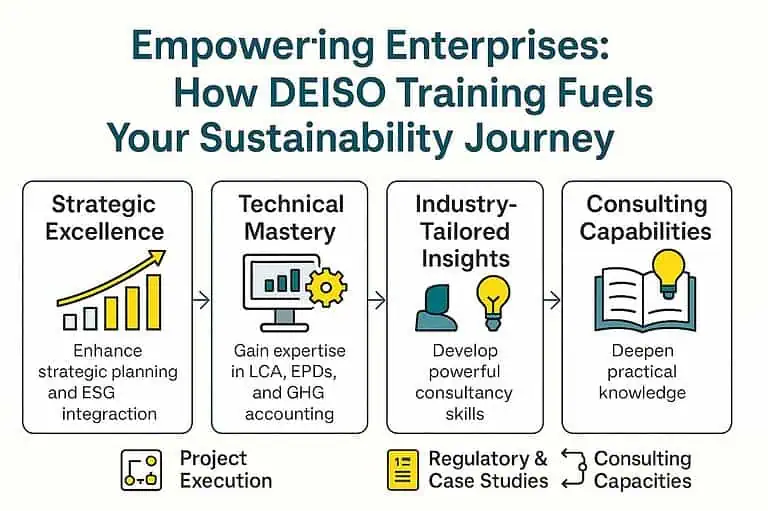
✅ Full List of References
- Reuters.com – Japan’s GHG Emission Trends and Energy Mix
- OECD.org
- Climate-transparency.org – Japan’s Energy and Emissions Profile
- Nippon.com – Japan’s Energy Import Dependency
- Weforum.org – Japan’s Hydrogen Transportation Strategies
- Japan Ministry of Environment (env.go.jp) – National GHG Statistics
- IPSS.go.jp – Japan’s Demographic Projections
- En.wikipedia.org – Japan Population Trends
- OECD.org – Circular Economy and Recycling in Japan
- OECD.org – Top Runner Energy Efficiency Program
- OECD.org – Plastic Resource Circulation and Waste Management
- OECD.org – Environmental Impact Assessment & Water Management
- OECD.org – Disaster Preparedness and Adaptation Planning
- OECD.org – Urban Green Infrastructure and “Sponge City” Initiatives
- OECD.org – Smart Cities and Compact Urban Development
- OECD.org – Biodiversity Protection and Satoyama Landscape Management
- OECD.org – Agricultural Reform and Biodiversity Links
- OECD.org – Fisheries Reform and Marine Protection
- OECD.org – TNFD and ESG Disclosure Growth in Japan
- OECD.org – Carbon Pricing and GX League Development
- OECD.org – Energy Subsidies and Economic Incentives
- OECD.org – Eutrophication and Water Pollution in Seto Inland Sea
- OECD.org – Municipal Waste Statistics and Treatment Methods
- OECD.org – Water Infrastructure Challenges in Rural Areas
- OECD.org – National Adaptation Plan and A-PLAT System
- OECD.org – LCA and GHG Methodologies
- OECD.org – Scope 3 and Scope 4 Disclosure Recommendations
- IPCC Data – Climate Change Alignment Targets (referenced contextually)

